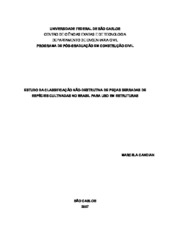Mostrar el registro sencillo del ítem
Estudo da classificação não-destrutiva de peças serradas de espécies cultivadas no Brasil para uso em estruturas
| dc.contributor.author | Candian, Marcela | |
| dc.date.accessioned | 2016-06-02T20:09:05Z | |
| dc.date.available | 2007-08-20 | |
| dc.date.available | 2016-06-02T20:09:05Z | |
| dc.date.issued | 2007-02-02 | |
| dc.identifier.citation | CANDIAN, Marcela. Study of nondestructive classification of sawed parts of cultivated species in Brazil for use in structures. 2007. 154 f. Dissertação (Mestrado em Ciências Exatas e da Terra) - Universidade Federal de São Carlos, São Carlos, 2007. | por |
| dc.identifier.uri | https://repositorio.ufscar.br/handle/ufscar/4609 | |
| dc.description.abstract | This research had for purpose comparatively to verify the accuracy of the techniques of transverse vibration and ultrasound to the values gotten in static testings, for sawed wood used in structures. With the results gotten in the development of the present research it was possible to calibrate the coefficient of modification (kmod, 3) of NBR 7190:1997, besides increasing the relative knowledge to the nondestructive tests in wood. In the experimental methodology studies with parts of structural members of Eucalyptus grandis, Eucalyptus citriodora, Pinus sp and Goupia glabra had been carried through, which had been classified using the techniques of ultrasound and transverse vibration, for the determination of the dynamic modulus of elasticity (Ed). Simultaneously to the tests with ultrasound they had been carried through the visual grading and tests of static bending (MOE). The values of coefficient of determination for the technique of transverse vibration (R² = 0,75, R² = 0,80, R² = 0,93 and R² = 0,89) and for the technique of ultrasound (R2 = 0,65, R2 = 0,76, R2 = 0,66 and R2 = 0,88), gotten respectively for the Eucalyptus grandis, Eucalyptus citriodora, Pinus sp and Goupia glabra are significant, demonstrating that the techniques of ultrasound and transverse vibration are important tools for nondestructive inference of the modulus of elasticity of wood. The technique of transverse vibration presented better resulted in relation to the ultrasound, therefore it presents one better tack enters the physical model of the phenomenon and the corresponding associated mathematical model. In the determination of the values of coefficient of modification kmod, 3, was verified that the technique of transverse vibration presented superior values of coefficient in relation the ultrasound technique, therefore allows a classification next to the values gotten in the static bending. | eng |
| dc.description.sponsorship | Universidade Federal de Minas Gerais | |
| dc.format | application/pdf | por |
| dc.language | por | por |
| dc.publisher | Universidade Federal de São Carlos | por |
| dc.rights | Acesso Aberto | por |
| dc.subject | Estruturas de madeira | por |
| dc.subject | Madeira | por |
| dc.subject | Ultra-som | por |
| dc.subject | Vibração transversal | por |
| dc.subject | Classificação mecânica | por |
| dc.subject | Wood | eng |
| dc.subject | Ultrasound | eng |
| dc.subject | Transverse vibration | eng |
| dc.subject | Mechanics classification | eng |
| dc.title | Estudo da classificação não-destrutiva de peças serradas de espécies cultivadas no Brasil para uso em estruturas | por |
| dc.title.alternative | Study of nondestructive classification of sawed parts of cultivated species in Brazil for use in structures | eng |
| dc.type | Dissertação | por |
| dc.contributor.advisor1 | Sales, Almir | |
| dc.contributor.advisor1Lattes | http://genos.cnpq.br:12010/dwlattes/owa/prc_imp_cv_int?f_cod=K4785912Y2 | por |
| dc.description.resumo | Este trabalho teve por finalidade verificar a acuracidade das técnicas de ultra-som e vibração transversal comparativamente aos valores obtidos em ensaios estáticos, para madeira serrada empregada em estruturas. Com os resultados obtidos no desenvolvimento deste trabalho foi possível calibrar o coeficiente de modificação (kmod,3) da NBR 7190:1997 - Projeto de Estruturas de Madeira, além de ampliar o conhecimento relativo aos ensaios não-destrutivos em madeira. Na metodologia experimental foram realizados estudos com peças de dimensão estrutural das espécies Eucalyptus grandis, Eucalyptus citriodora, Pinus sp e Goupia glabra, as quais foram classificadas mecanicamente utilizando as técnicas de ultra-som e vibração transversal, para a determinação do módulo de elasticidade dinâmico (Ed). Simultaneamente aos ensaios com ultra-som realizou-se a classificação visual das peças e ensaios de flexão estática (MOE). Os valores de coeficiente de determinação para a técnica de vibração transversal (R²= 0,75, R²= 0,80, R²= 0,93 e R²= 0,89) e para a técnica de ultra-som (R2 = 0,65, R2 = 0,76, R2 = 0,66 e R2 = 0,88), obtidos respectivamente para as espécies Eucalyptus grandis, Eucalyptus citriodora, Pinus sp e Goupia glabra, são significativos, demonstrando que as técnicas de ultra-som e vibração transversal são importantes ferramentas para inferência não-destrutiva do módulo de elasticidade da madeira. A técnica de vibração transversal apresentou melhores resultados em relação ao ultra-som, pois apresenta uma melhor aderência entre o modelo físico do fenômeno e o correspondente modelo matemático associado. Na determinação dos valores de coeficiente de modificação kmod,3, verificou-se que a técnica de vibração transversal apresentou valores superiores de coeficiente em relação a técnica de ultra-som, pois esta permite uma classificação mais próxima dos valores obtidos na flexão estática. | por |
| dc.publisher.country | BR | por |
| dc.publisher.initials | UFSCar | por |
| dc.publisher.program | Programa de Pós-Graduação em Engenharia Civil - PPGECiv | por |
| dc.subject.cnpq | ENGENHARIAS::ENGENHARIA CIVIL | por |
| dc.contributor.authorlattes | http://lattes.cnpq.br/7635127820758535 | por |
